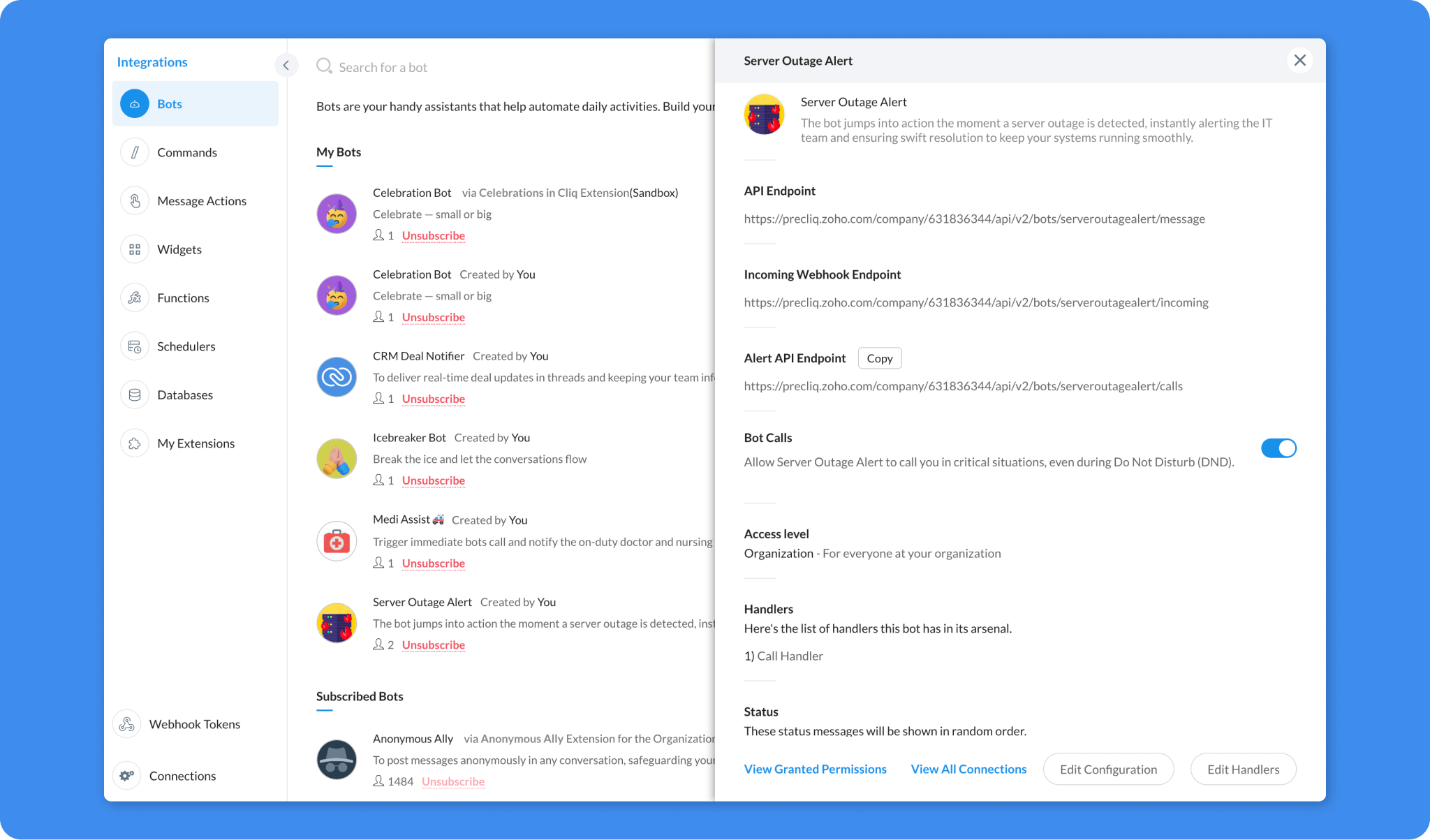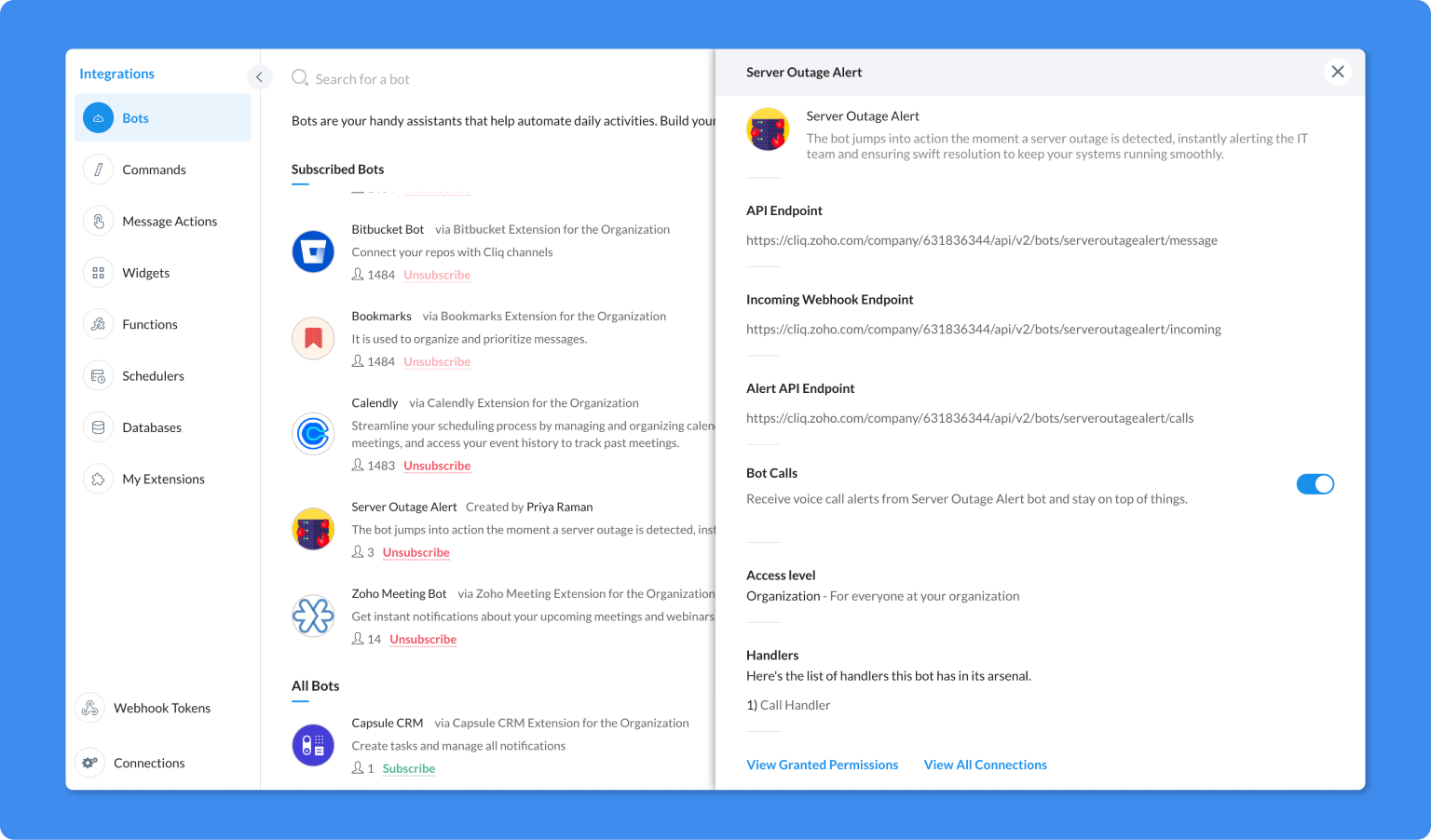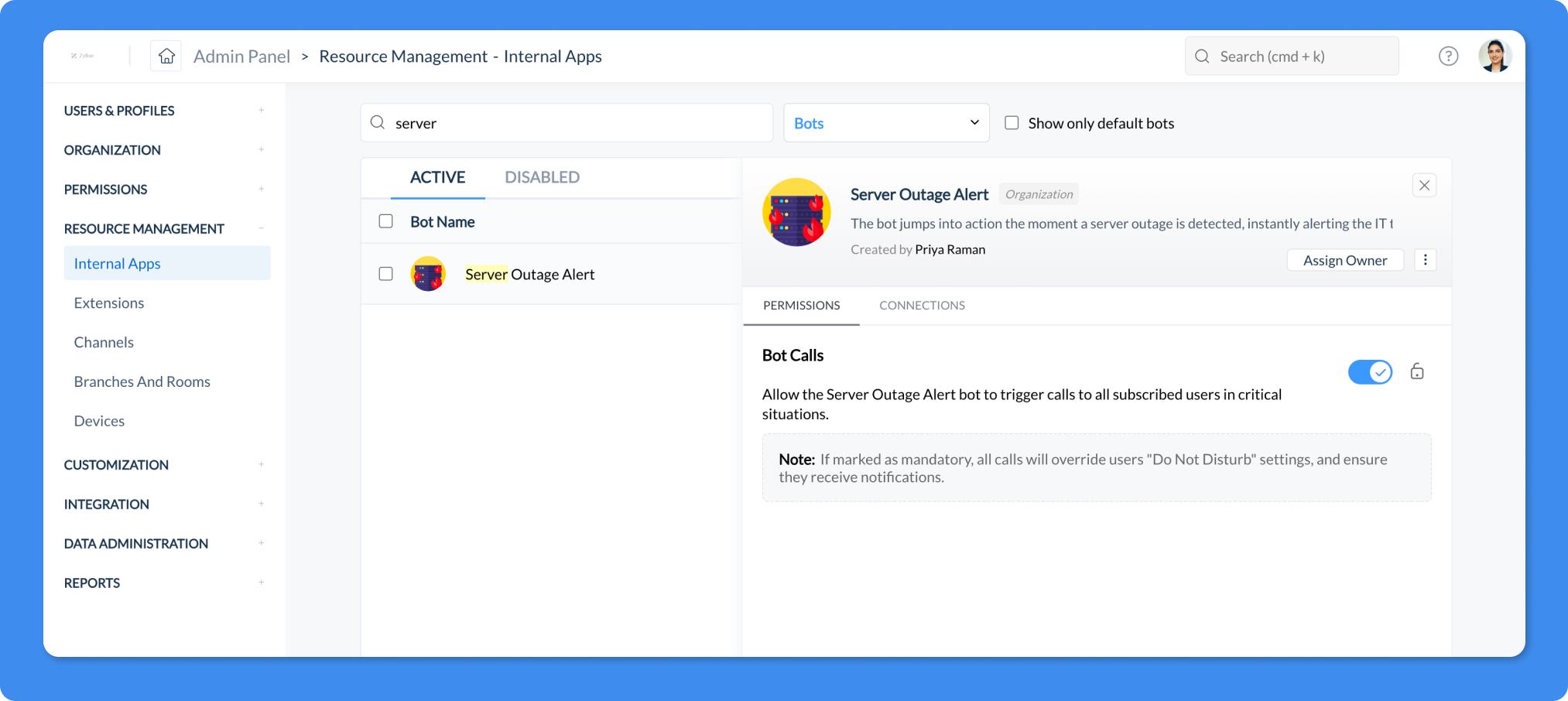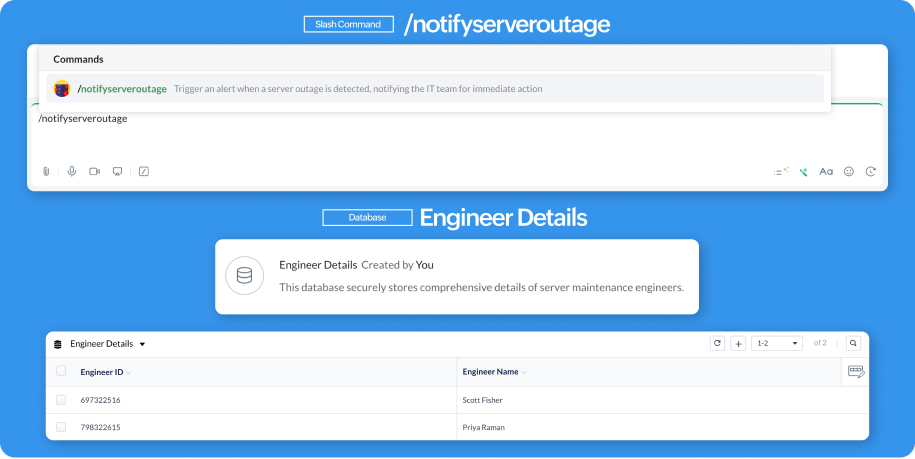Bot Call Handler
Timely communication makes a huge difference during a crisis. Whether notifying the IT team about a server crash or alerting a doctor about a patient's emergency, immediate assistance is necessary in critical scenarios! Cliq's Bot Calls guarantees top priority attention in crucial cases. Get ready to learn how to set up bot calls.

Enabling Bot Calls
You can enable bot calls while creating or modifying an existing bot.
Enabling Bot calls during new bot creation
Click on your profile picture, then select Bots and Tools.
Check the box to enable bot calls, then click Save Bot.

Enabling / Disabling Bot calls to an existing bot
For Developers (the bot's creator)
Click on your profile picture, select Bots and Tools, and navigate to the bot to which bot calls need to be enabled.
Navigate to your bot's configuration page, then toggle the checkbox to turn bot calls on or off and save the changes.

For Users (bot subscribers)
Click on your profile picture, select "Bots and Tools", and navigate to the bot to which bot calls need to be enabled/disabled.
Switch the toggle for bot calls to turn on/off based on the requirements.

For Admins
Admins can enable/disable bot calls for the whole organization via the Resource Management in the Cliq Admin Panel.
Click on your profile picture and navigate to the Admin Panel under the My Organization section.
Hover to the Resource Management option and choose Internal Tools.
Under the internal tools section, navigate to the bot to which bot calls must be enabled or disabled.
Under Permissions for the selected bot, you can enable, disable, or lock the permissions for users to enable or disable the bot calls for the whole organization.

Note :
Admins can disable the call setting (i.e. calls will be restricted) and mandate the call (i.e. even if a user turned off their call notification, they'll still receive it).All calls will override users Do Not Disturb settings and ensure they receive notifications.
Call Handler
The Call Handler lets you control how your bot responds to different call states and events. By editing the Call Handler, you can customize the bot's behavior based on specific call events, defining the bot's responses accordingly. The Call Handler triggers specific call events such as ringing, declining, or answering.

Call handler attributes
The list of attributes that are passed when the call handler is triggered is given below:
Attribute | Value | Description |
| operation | String Expected Values : | The operation attribute defines the specific event or action that occurs during a bot call. |
| data | Map | Details of the call event. which contains the call ID ( unique ID of the triggered call in Java UUID format ), time of execution (in Unix timestamp format) and retry count. |
| user | Map | Details of the user for whom the call was triggered |
| environment | Map | Details of the data center to which the user belongs. |
| access | Map | Details of the user's web client. |
Example response of data attribute in call handler :
{"call_id":"5c1cbd04-1396-42ba-aed1-4056a0350148","time":1728036292030,"retry":1}The operation attribute
The operation attribute defines the specific event or action that occurs during a bot call. It allows you to control the bot's response to each event, helping you customize its behavior based on the call's state. The bot's call handler is triggered by the following operations:
Operation type | Description |
ringing | When the call starts ringing. |
answered | When the call is answered by the user. |
ended | When the call is ended by either party. |
declined | When the user declines the call. |
missed | When the user misses the call without answering. |
offline | When the user is offline and cannot receive the call. |
busy | When the user is engaged in another call |
How to trigger a bot call?
To trigger a bot call, you need to use Cliq REST API to send a voice alert to specific users via bot.
POST
https://cliq.zoho.com/api/v2/bots/{BOT_UNIQUE_NAME}/calls
Quota Limit : The quota limit for this API is 10 calls for 5 minutes.The lock period is 30 minutes.
Authentication : This API can be accessed with the OAuth scope : ZohoCliq.Webhooks.CREATE or zapikey.
Parameters:
The following parameters are passed when a voice alert is triggered:
Request Body :
Attribute | Value | Description |
text* | String Max Length : 500 | The message to be dictated during the call. |
user_ids | Json Array Max Size : 1 - 10 | List of user ZUIDs or emails. |
retry | Integer Max Tries : 3 | Number of retries if the user misses the call (we call again in 2 mins) |
loop | Integer Max Tries : 3 | Number of times the message will be dictated during the call. |
| Json Array Max Limit : 5 | List of actions to be displayed as buttons during the call. Each action includes a label and a specific action. |
* Mandatory inputs
Action Button Attributes
Attribute Name | Value | Description |
label | String Maximum number of characters allowed : 20 | Display text of the button. |
hint | String Maximum number of characters allowed : 100 | A tool tip indicating the button's function while hovering over. |
Icon to indicate the action button | ||
type* | Allowed values: invoke.function | system.api | open.url | Specify the type of action the button should perform. |
Trigger Bot Call - Deluge Task
The zoho.cliq.triggerBotCall task can be used to trigger bot calls. This task requires you to provide the bot's unique name, message to be dictated as voice, and connection name.
Syntax: zoho.cliq.triggerBotCall(<bot_unique_name>, <bot_call_payload_map>, <connection_name>);
Example :
alertInfo = Map();
alertInfo.put("retry",1);
alertInfo.put("loop",2);
alertInfo.put("text","Alert! Immediate attention required to restore critical services.");
zoho.cliq.triggerBotCall("serveroutagealert",alertInfo,"oauthforbotcalls")
Usecase
Here’s a practical example of bot calls and call handlers in real life.
Bot calls can be used to trigger an emergency alert if maintenance engineers are unavailable in the event of server outages or network disruptions. This process ensures that the responsible engineer is notified quickly, acknowledges the critical issue, and immediately resolves it, preventing further damage.

A developer or user can execute the /notifyseveroutage slash command during downtime. This command triggers a bot call to notify a randomly selected engineer from a database named Engineer details, which contains details such as the engineer's name and ID.

/notifyseveroutage - Slash Command
Pre-requisite
Before beginning to script the code below, we must create a connection in Cliq. You can use created connection in Deluge integration tasks and invoke URL scripts to access data from the required service. Create a Zoho Oauth default connection with a unique name - oauthforbotcalls , with the scope - ZohoCliq.Webhooks.CREATE.
response = Map();
chatId = chat.get("id");
alertInfo = Map();
alertInfo.put("retry",1);
alertInfo.put("loop",2);
alertInfo.put("text","Alert! Server outage detected. Immediate attention required to restore critical services.");
actionButtons = List();
acknowLedgetButton = {"label":"Acknowledge","hint":"Confirming your availability for assistance.","icon":"tick","action":{"type":"invoke.function","data":{"name":"serveralertbuttonfunction"}},"key":chatId};
delegateButton = {"label":"Delegate","hint":"Redirect to another available server support engineer immediately.","icon":"headset","action":{"type":"invoke.function","data":{"name":"serveralertbuttonfunction"}}};
escalateButton = {"label":"Escalate","hint":"Escalate the alert to senior engineers or the next-level team","icon":"team","action":{"type":"invoke.function","data":{"name":"serveralertbuttonfunction"}}};
viewReportButton = {"label":"View Incident Report","hint":"View detailed report to understand the nature of the outage.","icon":"preview","action":{"type":"invoke.function","data":{"name":"serveralertbuttonfunction"}},"key":chatId};
triggerBackupButton = {"label":"Trigger Backup","hint":"Trigger backup systems to minimize downtime until the issue is resolved","icon":"add","action":{"type":"invoke.function","data":{"name":"serveralertbuttonfunction"}}};
actionButtons.add(acknowLedgetButton);
actionButtons.add(delegateButton);
actionButtons.add(escalateButton);
actionButtons.add(viewReportButton);
actionButtons.add(triggerBackupButton);
alertInfo.put("actions",actionButtons);
triggerBotCallAPI = invokeurl
[
url :" https://cliq.zoho.com/api/v2/bots/serveroutagealert/calls"
type :POST
parameters:"" + alertInfo
connection:"oauthforbotcalls"
];
info triggerBotCallAPI;
return response;
When the engineer answers the call, they'll receive an automated explanation of the server outage. Throughout the call, the engineer can use action buttons to:
Acknowledge : The maintenance engineer can click this button to confirm that they’ve received the alert and are working on the issue.
Delegate : If the engineer is unavailable,they can use this button to assign the task to another engineer.
Escalate : If the issue is critical and requires higher-level support,clicking this button can escalate the alert to senior engineers or the next level team.
View Incident Report : This button posts a detailed incident report,helping the team understand the nature of the outage.
Trigger Backup Systems : If configured,the maintenance team can click this button to automatically trigger backup systems to minimize downtime while resolving the issue.

Use action buttons with clear,intuitive icons tailored to specific use cases and user interfaces. Copy and paste the icon ID into your code to render them. For further information,please refer to the Icons in Cliq.
![]()
Actions initiated by clicking a button can be specified within a Cliq button function. Example: `serveralertbuttonfunction` in this case.
serveralertbuttonfunction - Button Function
key = arguments.get("key");
if(target.get("name").equalsIgnoreCase("Acknowledge"))
{
response = {"text":"The IT team is working on resolving the server outage and restoring service as soon as possible.","card":{"title":"Alert acknowledged","thumbnail":"https://cdn.dribbble.com/users/662779/screenshots/5122311/server.gif","theme":"prompt"}};
zoho.cliq.postToChat(key,response);
}
else if(target.get("name").equalsIgnoreCase("Escalate"))
{
response = {"text":"The maintenance engineer is currently unavailable. The server outage case has been reassigned to another available engineer for assistance","card":{"thumbnail":"https://i.imgur.com/Y2Nf4zS.png","theme":"prompt"}};
zoho.cliq.postToChat(key,response);
}
else if(target.get("name").equalsIgnoreCase("Delegate"))
{
response = {"text":"The issue has been escalated to senior engineers for immediate attention. A response team is now assigned to handle the critical case.","card":{"thumbnail":"https://i.imgur.com/Y2Nf4zS.png","theme":"prompt"}};
zoho.cliq.postToChat(key,response);
}
else if(target.get("name").equalsIgnoreCase("View Incident Report"))
{
response = {"text":"A critical outage was detected on Server 12. This affected core services, including user authentication and data storage access. The system experienced a sudden CPU overload leading to service failure.","card":{"title":"🌐 Incident Report - Server Outage","theme":"modern-inline"},"slides":{{"type":"table","title":"","data":{"headers":{"Incident Report","Details"},"rows":{{"Incident Report":"Incident ID","Details":"#1023"},{"Incident Report":"Date/Time","Details":"October 4 , 2024"}}}},{"type":"text","title":"⚙️ Root Cause","data":"Preliminary investigation indicates a spike in CPU usage due to a misconfigured scheduled task. The task led to an unhandled process overload, consuming excessive resources and resulting in server crash."}}};
zoho.cliq.postToChat(key,response);
}
else if(target.get("name").equalsIgnoreCase("Trigger Backup Systems"))
{
// Insert code to trigger backup systems
}
return Map();The call handler manages responses based on the user's actions during a bot call, such as declining or answering. Suppose the engineer is offline or declines the call. In that case, a message will be posted to notify you that the case has been reassigned to another available engineer. You can also configure it to trigger another bot call in case the engineer is unavailable.
Call Handler - Server Outage Alert Bot
if(operation.equalsIgnoreCase("answered"))
{
}
else if(operation.equalsIgnoreCase("declined") || operation.equalsIgnoreCase("missed") || operation.equalsIgnoreCase("offline"))
{
response = {"text":"The maintenance engineer is currently unavailable. The server outage case has been reassigned to another available engineer for assistance","card":{"thumbnail":"https://i.imgur.com/Y2Nf4zS.png","theme":"prompt"}};
zoho.cliq.postToBot("serveroutagealert",response);
}
The above workflow ensures a timely response, helping to avert downtime crises by efficiently utilizing Cliq platform components.
Call Management
To manage your bot calls:
Navigate to History > Direct Calls to view your call logs.
Here, you can track, review, and manage all bot calls. You can also access detailed transcripts and call recordings for further analysis.
Use the available action buttons to perform specific tasks related to each call.
After a bot call concludes, you can access the call transcript and use the action buttons to respond accordingly.
















